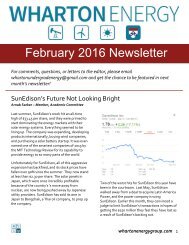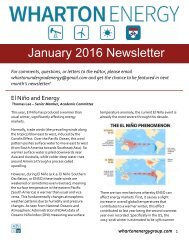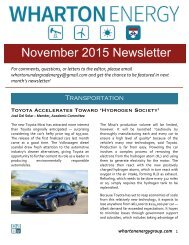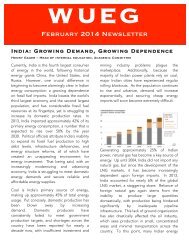Create successful ePaper yourself
Turn your PDF publications into a flip-book with our unique Google optimized e-Paper software.
an 84% capacity rate, so power plants are<br />
producing at full capacity almost all the time.<br />
In addition, having such a massive portion of a<br />
country’s electricity occasionally be generated<br />
by solar is damaging to other forms of power<br />
production. When a single source varies from<br />
50% of production to nothing at night, other<br />
plants need to compensate. This cycling of<br />
plants means nuclear (which varies its<br />
production over multiple days) cannot be part<br />
of the energy mix, so the other 95% of total<br />
daily production must come from gas and coal.<br />
The growing international consensus is that<br />
“Energiewende is the worst possible example<br />
of how to implement an energy transition. The<br />
overzealous push for the wrong generation<br />
technology has hurt citizens, businesses, and<br />
the environment all at the same time.” The<br />
German investment plan has caused higher<br />
energy imports, Germany’s highest coal usage<br />
in twenty years, and its highest electricity prices<br />
ever.<br />
We must instead follow China’s lead. The<br />
Chinese Academy of Sciences (CAS) has built a<br />
new nuclear research center in Shanghai with<br />
450 Scientists, with 300 more to be hired over<br />
the next year. Comparatively speaking, Penn<br />
currently has 113 faculty in the engineering<br />
school. CAS’s mission is not to build existing<br />
nuclear reactors, but innovate with novel fuels<br />
(Thorium), coolants (liquified salt) and plant<br />
designs (putting reactors underground, or<br />
floating on the ocean). China’s focus on solving<br />
their electricity problem is commendable, and<br />
will make China the intellectual leaders on<br />
nuclear power for years. Meanwhile, the US<br />
government instead is reducing grant<br />
programs to develop new low cost ‘Small<br />
Modular Reactors’.<br />
Nuclear poses a moral dichotomy. Humans can<br />
now split atoms in half, unleashing massive<br />
power that we harvest in giant, complex<br />
reactors. The energy harvested drives our<br />
industry, our offices, and our homes. Should<br />
this complex process go wrong, the entire<br />
country suffers, yet in the history of the world,<br />
only three reactors have malfunctioned.<br />
Advocates state that in terms of deaths per<br />
kilowatt, Nuclear is considered the safest form<br />
of energy available to the world. The<br />
argument states that proliferation risks are<br />
reduced due to new fuels and international<br />
protocols. They cite the tiny amount of<br />
radioactive waste, and increasingly effective<br />
storage techniques as making the waste point<br />
moot. Power produced from nuclear reactors is<br />
incredibly cheap and reliable over the entire<br />
lifetime of the plant.<br />
More importantly, the spectre of climate<br />
change looms large. As the battle between<br />
anti-nuclear and anti-carbon advocates rages,<br />
carbon dioxide is rapidly causing the earth to<br />
alter its basic processes. Nuclear power offers<br />
a simple, easy solution to this problem, directly<br />
replacing gas and coal plants with carbon-free<br />
electricity production. Solar and wind are a<br />
useful part of the energy mix, but nuclear<br />
power could be the country’s solution. Public<br />
apathy and misinformation are fueling the antinuclear<br />
contingent. Scientists and









